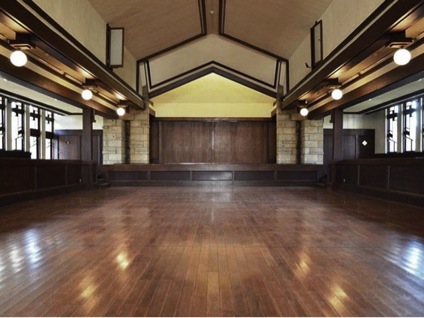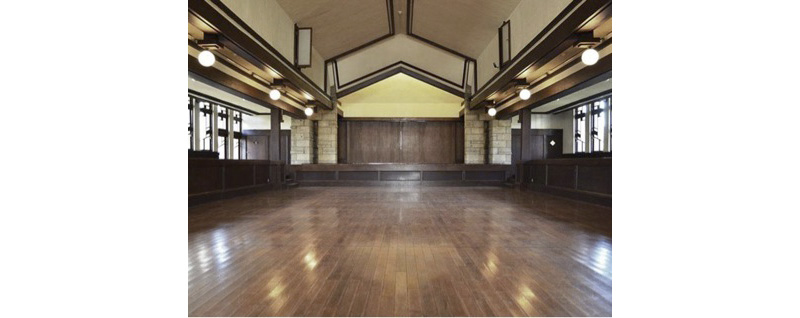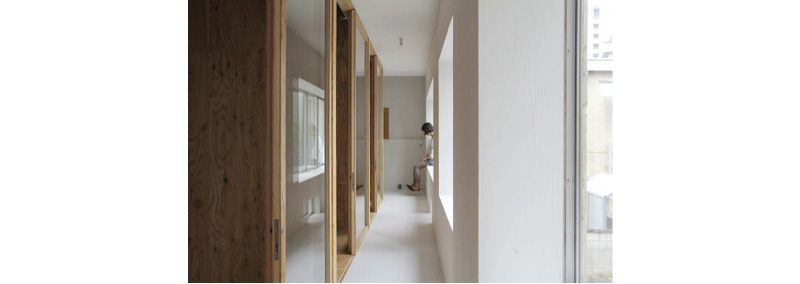
Towards “Build the house”
Mio Tsuneyama
In early spring of 2015, I, along with two professors, went to Frank Lloyd Wright’s Jiyu Gakuen Myonichikan. After attending the meeting that brought us there, the manager showed us the construction site of the restoration of the auditorium on the southern part of the site. This timber structure was built in 1927, just after […]
In early spring of 2015, I, along with two professors, went to Frank Lloyd Wright’s Jiyu Gakuen Myonichikan. After attending the meeting that brought us there, the manager showed us the construction site of the restoration of the auditorium on the southern part of the site. This timber structure was built in 1927, just after the 1923 Great Kanto Earthquake by Arata Endo 1.

Jiyu Gakuen Myonichikan Auditorium
Arata Endo
After breaking the “Sakoku” 2 in 1875, the Japanese government invited foreign teachers in order to teach western technology, culture, philosophy and also architecture. This was the very first moment the “architect” as a professional was recognized in Japan. Traditionally, the “architect” had not existed in Japan, in his place, the “Toryo” 3, the master carpenter planned, built and managed the construction site.
The manager of Jiyu Gakuen told us that during the restoration, they founded a lot of experimental traces of Arata Endo. For example, when the the wall and ceiling finishes of the main space were removed for the structural reinforcement, they found that the structure did not look like it had been built by the “Toryo”, who generally lead the construction site of timber structures at the time. An unusual construction was used, a “2×4” roof construction brought by F. L. Wright, carried by only four pillars and high beams in the longitudinal direction, which seems an influence of japanese conventional wood framing, to gain stability against horizontal forces making it indispensable after the earthquake. This unusual structure system makes the main hall unprecedented in its constructive aspect.
At the time of post-earthquake rehabilitation, when budget and materials were limited, the Jiyu Gakuen needed the space for lectures, as soon as possible. In order to overcome the shortage of time and funds, Endo hired normal carpenters without so-called “Toryo” who were open to new ways of construction and detailing, not bound by preconceived ideas, and who could also take time to consider and try again and again with the architect. Endo made this experiment possible by taking responsibility over the budget and hiring and managing the workers.
FUDOMAE House
We are currently facing poverty that could be compared to the one felt at the time of Arata Endo after the Great Kanto earthquake. This poverty does not mean starving or shortage of materials, but lack of quality of life. People have to work hard from day to night just to earn enough to cover their basic needs in modern urban society. To break free from this state of being “working poor”, people are shifting their lifestyle and workstyle too, trying to cut costs in renewed ways. The prevalence of the “Share house” model is one of the phenomenon caused by this situation. People prefer to share apartments or houses with other people in order to be able to “have” larger spaces without having to spend large amounts of money with the rent in the middle of city.
In the Spring of 2013, I was invited to renovate the house of a former school friend. She had bought a 1970s two-storey detached house, together with her partner. The house had a large storeroom on the ground floor and they planned to renovate it into a house for seven people, who would live together sharing a living room, a kitchen and a bathroom – a so-called “share house” 4. In order to fit the new uses into the share house with seven bedrooms, we needed to re-organize the plan. The budget was limited, so the clients and I decided to paint the walls, floors and ceilings ourselves, helping to reduce the construction fee.
The Client, the client‘s parents and myself painted at the end of the construction process, for a period of ten days in total. I was very pleased to join for the painting as a friend, to spend time with them and to get to know their parents. On the other side, I ended up not being able to check on the other work still going on on the construction site. To have missed these inspections caused misunderstandings with the workers, who had to do things again. This imposed a burden on them and, at the end, it could have created an additional fee for the client. The aim was to make the cost lower but this process was reversing the seemingly logical order.

DO IT YOURSELF
The house has become charming and seems to be a happy place for its inhabitants now. It has also gained some architectural interest by creating several shared spaces for them. But the experience at the end of construction in the site made me think about the role of the architect. By inserting myself in the construction process as a “construction worker”, I might have lost the real workers confidence on me and, what is worse, they might have seen me as an intruder. I asked myself whether painting was just my egotism as an architect to achieve my ”ideal space”…
We increasingly see young architects “do it yourself” with their client to realize their design, professing it as part of their design concept or working attitude as an architect. The reason might be that the client’s budget might not be large enough and/or that to pay for an architect is not yet instilled in Japanese culture. With this kind of DIY approach towards construction, the quality is clearly not the same as it would be when the construction is done by workers who have trained for years to master a specific technique. I am not skeptical towards “do it yourself”, because it might be the trigger for clients to decide that a house is not something to buy but to be built. But if the architect joins in, it might mean that unprofessional detailing or construction is admitted. This in turn ignores the worker’s value and prevents the inheritance of knowledge and the high quality technic of Japanese construction, which we can be proud of it.
Versus “Buy the house”
A year and half after the completion of the FUDOMAE House, the construction manager was declared bankrupt. He was an independent contractor and worked as such: he received his orders from the architects, arranged all the workers and managed all the cost; this is the general situation of construction in Japan. Therefore, the quality of the construction greatly depends on the building contractors.
The architects who worked with him were admired and pleased when they understood that the construction manager was very conscious about design issues and had a really good network of all different kinds of qualified professional workers. Also in the FUDOMAE House, the workers were concerned not only with their task, but with the whole construction, allowing them to help each other and discuss details and possible solutions to unexpected situations. This created a good team, which also included the architect and the client. I do not think that it was only the FUDOMAE House’s construction that brought financial problems to the construction manager, but it is not difficult to imagine that the architect‘s amateur attitude, like the one I had, affected his budget little by little.
This incident indicates that the existing system we have in Japan, does not fit to small projects with small budgets. It would have probably worked well if the clients would/could spend more money on the construction process and this would allow the contractors to pull some money for covering unforeseen trials and tribulations during the construction process.
But as we are facing the “lack of budget”, using this system is unreasonable. If architects would not break-through the existing system and would not contrivehow to manage the construction site, we could not support the small networks of workers like the construction manager of FUDOMAE House had, they could never assure the quality of their work. To use a product which is embedded into industrialization, is cheaper and easier. If the architect does not find the quality of experimental construction and manages to convince the client of this added value, the client will go to the easier solution, as to buy a ready-made house. Then clients will tend to “buy the house” and not “build the house”. A direct consequence of this, from my point of view, would be that architecture could be completely absorbed by the system of industrialization.
Experimental Field
The working environment that Endo tried to create with the Jiyu Gakuen Auditorium made experimental construction possible with a small budget. But the way he did it, investing time in trying and thinking together with carpenters, looking for solutions for the structure’s system or detailing, was only possible at Endo’s time when the labor was not as expensive as it is today. Or is it? How can we recreate this kind of experimental construction site without going into DIY or exploding the available budgets?
As a young architect, who has small scale projects with small budgets, I struggle with the fatalism of industrialization. The DIY is a possible stand against this situation but it does not necessarily leads to an improvement of the architectural realm. Our role as architects is not only to design, but also to care for the inheritance and development of quality of workers’ skills. To build a network of qualified workers that will then in turn assure the quality of the work of the architect. Maybe then, we will get the chance to attain a high level of quality in our built environment, from the design phase to handcraft detailing, despite our small budgets, despite the industrial system, despite our own egos.
1 Arata Ento (1886-1951):Japanese architect who was chief assistant to Frank Lloyd Wright on the construction site for Tokyo Imperial hotel.
2 Sakoku, „Locking country“: In the Edo Era Japan refused to have any relationship with other countries, except for China, Portugal and Netherlands.
3 Toryo is the master of carpenter who leads the construction site.
4 Share House: a kind of flat sharing, which recently gained popularity in Japan. It often involves the renovation of the single-family house, which is no longer lived in.